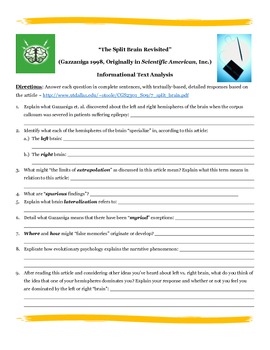Psychology: Split Brain Theory ~ Informational Text Critical Thinking Activity
Engaging Language Arts and Psychology
188 Followers
Grade Levels
9th - 12th, Higher Education, Adult Education, Homeschool
Subjects
Resource Type
Standards
CCSSRST.9-10.1
CCSSRST.9-10.2
CCSSRST.9-10.4
CCSSRST.9-10.5
CCSSRST.9-10.6
Formats Included
- PDF
Pages
1 page
Engaging Language Arts and Psychology
188 Followers
Description
This is a polished, graphic, new, single page 2013 PDF for critical thinking analysis of a 1998 article in Scientific American on the arguments and science behind left vs. right brain or brain lateralization. The question set could be addressed individually by students, in small collaborative groups, or as a whole group Q and A discussion to inspire problem-solving and critical thinking on a timely, hot topic in contemporary Psych/brain studies.
I have found this to be a highly thought-provoking and dialogue-generating article and critical thinking analysis in my Psychology classroom, and think that you will as well -- or perhaps in your Biology course(s). I have included the hyperlink to the Scientific American article/PDF. The informational text-based questions are original, and will help your students do the following:
a.) comprehend a contemporary informational article on hotly contested "brain lateralization" studies
b.) analyze points made throughout the hyperlinked article -- their merit, examples provided, and content-specific language used, etc.
c.) evaluate argument(s) given in the text about brain specialization
d.) connect with the points made about brain lateralization
e.) write in complete sentences in response to an informational text
Students will be encouraged to apply their learning from this article to their own lives: in this way, you will be inviting students to develop the Common Core State Standards for reading/writing and speaking/listening with informational text, as well as utilizing 21st Century Skills, including critical thinking/problem-solving. Students will thus be invited into the higher levels of Bloom's Taxonomy (eg. moving beyond understanding to application, analysis, and evaluation)!
This article analysis would work well within a Biological Foundations unit, and would pair well with the 3D Brian Model PPT Playdoh/Modeling Clay activity available in my store. I am confident that not only will you enjoy this activity, but that your students will as well. Thank you for visiting my store, and I look forward to your feedback!
I have found this to be a highly thought-provoking and dialogue-generating article and critical thinking analysis in my Psychology classroom, and think that you will as well -- or perhaps in your Biology course(s). I have included the hyperlink to the Scientific American article/PDF. The informational text-based questions are original, and will help your students do the following:
a.) comprehend a contemporary informational article on hotly contested "brain lateralization" studies
b.) analyze points made throughout the hyperlinked article -- their merit, examples provided, and content-specific language used, etc.
c.) evaluate argument(s) given in the text about brain specialization
d.) connect with the points made about brain lateralization
e.) write in complete sentences in response to an informational text
Students will be encouraged to apply their learning from this article to their own lives: in this way, you will be inviting students to develop the Common Core State Standards for reading/writing and speaking/listening with informational text, as well as utilizing 21st Century Skills, including critical thinking/problem-solving. Students will thus be invited into the higher levels of Bloom's Taxonomy (eg. moving beyond understanding to application, analysis, and evaluation)!
This article analysis would work well within a Biological Foundations unit, and would pair well with the 3D Brian Model PPT Playdoh/Modeling Clay activity available in my store. I am confident that not only will you enjoy this activity, but that your students will as well. Thank you for visiting my store, and I look forward to your feedback!
Total Pages
1 page
Answer Key
Does not apply
Teaching Duration
40 minutes
Report this resource to TPT
Reported resources will be reviewed by our team. Report this resource to let us know if this resource violates TPT’s content guidelines.
Standards
to see state-specific standards (only available in the US).
CCSSRST.9-10.1
Cite specific textual evidence to support analysis of science and technical texts, attending to the precise details of explanations or descriptions.
CCSSRST.9-10.2
Determine the central ideas or conclusions of a text; trace the text’s explanation or depiction of a complex process, phenomenon, or concept; provide an accurate summary of the text.
CCSSRST.9-10.4
Determine the meaning of symbols, key terms, and other domain-specific words and phrases as they are used in a specific scientific or technical context relevant to grades 9–10 texts and topics.
CCSSRST.9-10.5
Analyze the structure of the relationships among concepts in a text, including relationships among key terms (e.g., force, friction, reaction force, energy).
CCSSRST.9-10.6
Analyze the author’s purpose in providing an explanation, describing a procedure, or discussing an experiment in a text, defining the question the author seeks to address.


